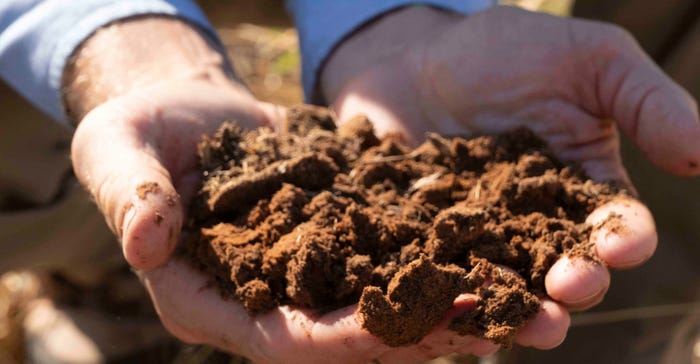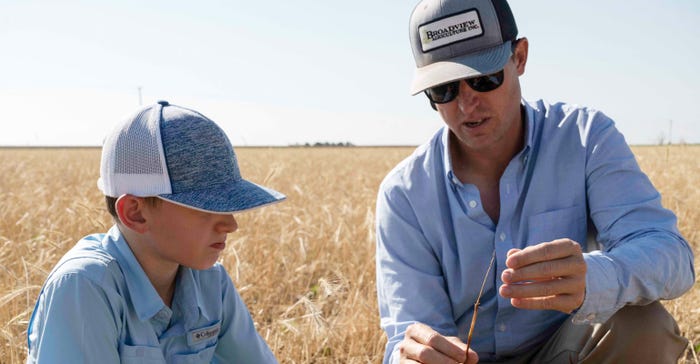When it comes to land management, Jeremy Brown, owner of Broadview Agriculture Inc., has a clear vision of what he hopes to accomplish on his Dawson County farm. But that vision is something that stretches well beyond his family's 5,000-acre farm near Lamesa, Texas.
“I don’t ever want to be a farmer who thinks he’s figured it out,” he says. “The person who created this is so much bigger than me. And I’m constantly trying to learn how He created it, how it functions, and what I can do to work alongside it.”

“The person who created this is so much bigger than me. And I’m constantly trying to learn how He created it, how it functions, and what I can do to work alongside it,” says Dawson County, Texas, producer Jeremy Brown. (Photos by Quenna Terry, NRCS)
A fourth-generation farmer, Brown grew up working the land with his grandad and his father but says how he farms today is 100% opposite of the way they farmed back then.
His focus is on conservation planning rather than turning out crop after crop. Over the years, Brown’s worked closely with the USDA Natural Resources Conservation Service (NRCS) to use multiple regenerative farming practices to raise cotton.
“The NRCS has been a valued resource for me and my operation, both locally and nationally. There’s just so much good information out there that can help us farmers to grow and to learn.”
Married with four children, Brown says his son and three daughters often work in the field with him.
“One of the things I love about production agriculture is that it’s a family business." He hopes to teach his children about the importance of stewardship.
Broadview
Brown is introspective and reflective in everything he does. Even the name, Broadview, was carefully chosen.
“We named it Broadview for multiple reasons. As you can see, the view is very broad, but we also did that because we wanted to have a broad perspective on the way that we farm. We don’t want to be closed-minded on ‘this is the way it’s always been done’ or ‘this is the only thing that grows here’ and so we try to have a very broad perspective in the things that we do and the crops that we grow.”
Organic farming
Organic certified cotton and non-organic cotton is the family’s main crop, but they also grow wheat, grain sorghum, and sesame. Brown says they grow other crops to heal the land and bring rotation and diversity based on soil health principles that include limiting disturbance, diversity, animal integration, always having a root in the soil, and maintaining cover.

Jeremy Brown with his son. “One of the things I love about production agriculture is that it’s a family business." He hopes to teach his children about the importance of stewardship.
In 2013, Brown says he started reading about hairy vetch, a cover crop that helps protect the soil from erosion, improves soil tilth, and provides weed control. The discovery opened his mind to an entirely new way of farming.
“I’m a big believer in cover crops,” he says. “When we first started doing it, we were mainly growing winter wheat to keep the wind from blowing [and causing] erosion.”
Brown believes cover crops are the only way for his operation to remain sustainable into the future. “Our goal is always to have a grass, a legume and a brassica if we can. Timing challenges and lack of rain plays into it, but that’s our goal.”
Brown understands why some farmers are hesitant to try more conservative farming practices, with a desire to find that “quick fix,” solution instead. He says restorative farming and growing cover crops is a five-year commitment, if not longer.
“We use the cover crop to always have something growing to feed those microbes, bacteria and fungi. All the things we can’t see that need to live and root to survive. I’m really passionate about that and I’m seeing the benefits of that.”
Timely rains are important to his operation but not always available on the Texas South Plains, creating a need to be flexible.
When it does rain in his region, Brown says it comes heavy and the evaporation rate is often higher than the rainfall amount, and the area can be very windy.
One way he tries to work with and make the most of what nature gives him, good or bad, is to always have seed available. “And if there’s a timely rain, we’re going plant something if there’s nothing growing on that piece of land.
“We believe passionately about having that living root and having diversity in the soil. We used to just be so monoculture and I just want as much diversity as we can. And so yeah, it’s a goal of ours that sometimes we achieve it and sometimes we don’t.
“It’s a challenge and so that’s where resources like NRCS are really helpful.”
A mutual partnership
NRCS Lamesa Resource Team Leader Hal Rogers has worked with Brown on multiple projects for nearly a decade.

NRCS Lamesa Resource Team Leader Hal Rogers.
“[Jeremy] was the one that kind of started the relationship by coming in the office and asking for some assistance and looking at different things he was looking at doing. We just kind of blossomed working with him from that point on through different practices and ideas,” Rogers says.
“We learned a lot from each other moving into this new era of soil health.”
Since discovering how the NRCS can help, Brown has partnered on a variety of conservation-based projects.
“We’ve worked in many facets with Jeremy. We’re standing in a field of grass that we helped him in seeding, using different programs, including just grass planting and also pollinator habitat to try and help his organic operation,” Rogers says. The field is seeded with mixed grasses, flowers, and other beneficial plants.
Where Brown uses conventional tillage, Rogers says the NRCS has worked with him to increase pivot efficiency by utilizing available irrigation water in a way that benefits his crops while also saving water.
“That’s been his goal – utilizing the newest technology and the best system to try to do that,” Rogers says.
NRCS Agronomist Brandt Underwood describes Brown as an early adopter on conservation. Underwood says using mixed species cover crops—which consists of varying grasses, forbs, and legumes together—is a unique idea for this part of the world. Annually, Brown plants cover to improve soil health, increase soil organic matter, and help control erosion.
“Jeremy has been implementing this practice on his farm over the last several years with good success,” he says.
“Wind erosion is a major resource concern for the Texas High Plains, and the farmers have to manage that quite diligently. Right here, we have an excellent example of one very successful farmer managing his wind erosion quite well,” Underwood adds.
The future of farming
Underwood, who has worked with Brown on multiple projects, describes Brown and Broadview Agriculture as “the new generation of farmer.”
“Jeremy is an early adopter and he’s applying a lot of conservation practices. He has an education and he’s structured much more like a business, so to speak.

NRCS Agronomist Brandt Underwood has worked with Jeremy Brown on several complex projects.
“He’s a family farm, but he’s developed a mission statement. Within that, he has specific conservation goals. Part of those goals is to be able to leave this land better than he found it. Therefore, if his children would like to continue to farm in the future, he realizes his responsibility to the land and to the American public to support us with a safe and reliable source of food and fiber,” Underwood says.
Brown has converted Conservation Reserve Program acres into organic certified land. The NRCS wrote a compliance plan to help Brown meet the requirements of the 1985 Food Security Act, including measures to conserve natural habitat.
The agency also provides Brown with technical information and studies, including the science behind recommended techniques.
“We’re also learning from Brown on those aspects of what really works for a farmer and what doesn’t and trying to incorporate that into everything we do on a day-to-day basis,” Rogers says.
Brown remains excited to identify and implement ways of improving his land resources and health.
“There’s nothing that I’d rather do than be a steward of the land. It’s one of my favorite things,” Brown says. “I find myself just wanting to grow and learn how we can manage what God has given us and hopefully leave it better than we found it.”
Brown is the president of the Dawson County Farm Bureau, serves on the executive committee of the area’s Plains Cotton Growers—a non-profit producer organization composed of cotton growers from the Texas High Plains—and serves on the board of the Agriculture Texas Farm Credit and Texas Organic Marketing Cooperative.
Source: is NRCS, which is solely responsible for the information provided and is wholly owned by the source. Informa Business Media and all its subsidiaries are not responsible for any of the content contained in this information asset.
About the Author(s)
You May Also Like




